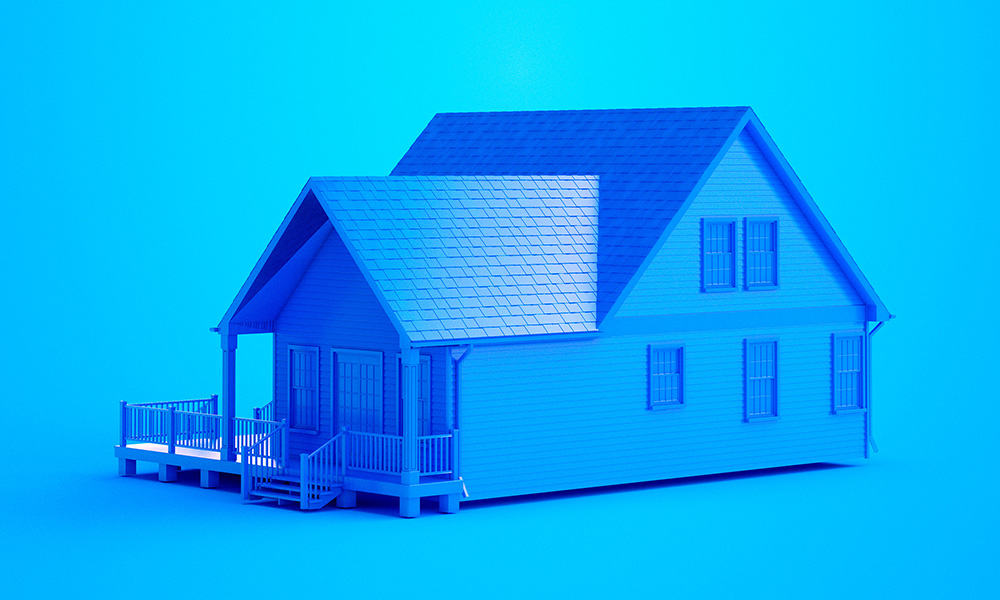
21世纪00年代中期的大萧条(Great Recession)给我们留下的创伤还未完全愈合,尤其是在房地产领域。据估计,2006年至2014年间,美国大约有1000万人因为丧失抵押品赎回权而失去了他们的房屋。在那之前的一段时间,宽松的信贷政策助长了疯狂的投机性购房行为。如今美国的房地产市场再次一飞冲天,全国房价较去年上涨了近19%,人们似乎有理由担心另一个房地产泡沫正在酝酿当中。
如果要判断目前的房地产市场是否存在泡沫,就首先要了解什么是房地产泡沫。当一种资产价格上涨的速度超过基本面的支撑能力时,泡沫就会出现,这种上涨往往是由过度乐观的投机行为或宽松的融资环境所驱动的。另外,泡沫也需要一个崩盘期,此时资产价格暴跌的速度超过了基本面。如果只是价格上涨,则不是泡沫产生的迹象。
与上一次的房地产热潮不同,有些人会觉得自新冠疫情开始以来的这波涨价是有道理可循的。首先美国的人口结构足以支撑房地产市场的增长,其次随着人们的积蓄越来越多,居家时间越来越长,他们拥有房产的愿望也就更加强烈。新冠疫情改变了生活方式,进而导致许多美国人重新评估自己的生活安排,一些租房族开始找房买房,而一些原本就有房子的人也选择出售旧宅,入住更大的房子。
由于各种原因,包括对新冠疫情的恐惧,美国现有住房的供应量迅速下降,而购房需求又正好跃升。另外,房屋建筑商在上一个周期后变得更加谨慎,它们投放进市场的房屋数量比较保守,所以新房的供应同样吃紧。
在供不应求的情况下,房价便节节攀升,但涨幅也只是冰山一角。美国的标准普尔500指数(S&P 500)较去年上涨了31%,房产净值也增加了近20%,一些美国人在这一年中变得相当富有。另外也有一部分人因为远程办公而搬家,而且通常是从高成本地区搬到低成本地区,所以也相对富裕了起来。
当然,房价上涨的最大推手还是抵押贷款利率。从2002年到2005年的房地产高峰期,30年期固定抵押贷款利率平均为6%。相比之下,从2020年4月到现在的抵押贷款利率平均只有3%。
从历史上来看,在鼓起胆量投入房地产泡沫之前,可以先看看房价与收入的比例。虽然房价看起来是比收入高,但这并没有把利率考虑在内。住房支付与收入的比例是衡量负担能力的一个重要指标,我们能够看到其水平低于上一个周期,这体现了廉价融资的威力。
此外,政府自大萧条以来便采取了措施,预防房地产市场再次出现类似的崩盘。现在可以获得的抵押贷款比21世纪00年代中期要紧得多,而且风险更大的可调利率抵押贷款占购买和再融资贷款的比例不到5%,上一个周期的峰值可是超过了35%。
然而,房地产市场还是有一些不健康的迹象。作为上个周期的主力军,投资者这次又回来了。全现金销售是追踪投资者活动的一个常见措施,其占到总交易量的23%。这一数据虽然超过去年的15%,但与2011年的35%相比还是存在一定差距。购房者正感受到投资者活跃在市场上的影响,尤其是在最低价位上。
不管是以前还是现在,都有人害怕“过了这个村没这个店”,所以便草率地做出决定。他们担心现在不买房的话,以后可能再也买不到了。这一想法引发了竞价战,而定价的压力也在上升,首次购房者和低收入购房者于是发现自己被挤出了市场。其他人则觉得现在房价炒得太热,一些有经济能力的人甚至也已经到了临界点,对价格望而却步。
在前进的道路上,令人感到欣慰的是许多抵押贷款防护措施到位,信用度很高,市场上基本没有投机性贷款。虽然现在的价格还算合理,但明智的人不会觉得只升不降。
房地产市场的最大风险是抵押贷款利率上升,明年很有可能会出现这种情况,从而导致价格下降。此外,经济、金融和信心方面的挑战也可能导致房价下跌或持平,即便买家群体依然坚实。但是房价无论是下跌还是持平,与我们在大萧条期间遇到的崩盘相比都不值一提。(财富中文网)
阿里·沃尔夫是Zonda公司的首席经济学家。
译者:秦维奇
21世纪00年代中期的大萧条(Great Recession)给我们留下的创伤还未完全愈合,尤其是在房地产领域。据估计,2006年至2014年间,美国大约有1000万人因为丧失抵押品赎回权而失去了他们的房屋。在那之前的一段时间,宽松的信贷政策助长了疯狂的投机性购房行为。如今美国的房地产市场再次一飞冲天,全国房价较去年上涨了近19%,人们似乎有理由担心另一个房地产泡沫正在酝酿当中。
如果要判断目前的房地产市场是否存在泡沫,就首先要了解什么是房地产泡沫。当一种资产价格上涨的速度超过基本面的支撑能力时,泡沫就会出现,这种上涨往往是由过度乐观的投机行为或宽松的融资环境所驱动的。另外,泡沫也需要一个崩盘期,此时资产价格暴跌的速度超过了基本面。如果只是价格上涨,则不是泡沫产生的迹象。
与上一次的房地产热潮不同,有些人会觉得自新冠疫情开始以来的这波涨价是有道理可循的。首先美国的人口结构足以支撑房地产市场的增长,其次随着人们的积蓄越来越多,居家时间越来越长,他们拥有房产的愿望也就更加强烈。新冠疫情改变了生活方式,进而导致许多美国人重新评估自己的生活安排,一些租房族开始找房买房,而一些原本就有房子的人也选择出售旧宅,入住更大的房子。
由于各种原因,包括对新冠疫情的恐惧,美国现有住房的供应量迅速下降,而购房需求又正好跃升。另外,房屋建筑商在上一个周期后变得更加谨慎,它们投放进市场的房屋数量比较保守,所以新房的供应同样吃紧。
在供不应求的情况下,房价便节节攀升,但涨幅也只是冰山一角。美国的标准普尔500指数(S&P 500)较去年上涨了31%,房产净值也增加了近20%,一些美国人在这一年中变得相当富有。另外也有一部分人因为远程办公而搬家,而且通常是从高成本地区搬到低成本地区,所以也相对富裕了起来。
当然,房价上涨的最大推手还是抵押贷款利率。从2002年到2005年的房地产高峰期,30年期固定抵押贷款利率平均为6%。相比之下,从2020年4月到现在的抵押贷款利率平均只有3%。
从历史上来看,在鼓起胆量投入房地产泡沫之前,可以先看看房价与收入的比例。虽然房价看起来是比收入高,但这并没有把利率考虑在内。住房支付与收入的比例是衡量负担能力的一个重要指标,我们能够看到其水平低于上一个周期,这体现了廉价融资的威力。
此外,政府自大萧条以来便采取了措施,预防房地产市场再次出现类似的崩盘。现在可以获得的抵押贷款比21世纪00年代中期要紧得多,而且风险更大的可调利率抵押贷款占购买和再融资贷款的比例不到5%,上一个周期的峰值可是超过了35%。
然而,房地产市场还是有一些不健康的迹象。作为上个周期的主力军,投资者这次又回来了。全现金销售是追踪投资者活动的一个常见措施,其占到总交易量的23%。这一数据虽然超过去年的15%,但与2011年的35%相比还是存在一定差距。购房者正感受到投资者活跃在市场上的影响,尤其是在最低价位上。
不管是以前还是现在,都有人害怕“过了这个村没这个店”,所以便草率地做出决定。他们担心现在不买房的话,以后可能再也买不到了。这一想法引发了竞价战,而定价的压力也在上升,首次购房者和低收入购房者于是发现自己被挤出了市场。其他人则觉得现在房价炒得太热,一些有经济能力的人甚至也已经到了临界点,对价格望而却步。
在前进的道路上,令人感到欣慰的是许多抵押贷款防护措施到位,信用度很高,市场上基本没有投机性贷款。虽然现在的价格还算合理,但明智的人不会觉得只升不降。
房地产市场的最大风险是抵押贷款利率上升,明年很有可能会出现这种情况,从而导致价格下降。此外,经济、金融和信心方面的挑战也可能导致房价下跌或持平,即便买家群体依然坚实。但是房价无论是下跌还是持平,与我们在大萧条期间遇到的崩盘相比都不值一提。(财富中文网)
阿里·沃尔夫是Zonda公司的首席经济学家。
译者:秦维奇
The wounds from the Great Recession of the mid-2000s are still healing, especially when it comes to housing. An estimated 10 million people lost their homes to foreclosure from 2006 to 2014, following a period of frenzied and speculative homebuying fueled by easy credit. The housing market is yet again on a tear with home prices up nearly 19% nationally compared with last year, and that has people rightfully worried that another housing bubble is brewing.
In order to determine if the current housing market is in a bubble, one needs to ask what constitutes a housing bubble. A bubble is present when the price of an asset is rising faster than the fundamentals can justify, often driven by overly optimistic speculation or loose financing. Moreover, a bubble requires conditions that would permit a crash—that is, a period of asset prices falling faster than fundamentals. Rising prices alone, however, are not a sign of a bubble.
Unlike the last housing boom, one could argue that home price growth since the start of the pandemic was justifiable. The demographics of the U.S. were already supporting housing growth and the desire to own only increased as people saved more and spent more time at home. The lifestyle change brought on by the pandemic caused many Americans to reassess their living arrangements, including some renters that turned into house hunters and some existing homeowners that sold to move into a larger home.
The jump in homebuying demand hit right as existing housing supply declined rapidly for a variety of reasons, including fear of COVID-19. Homebuilders, most of whom became more prudent following the last cycle, were cautious with how many homes they were bringing to the market, resulting in equally tight new home inventory.
The supply and demand mismatch pushed prices upward, but that was just the tip of the iceberg for rising home values. Some Americans became much wealthier over the past year following a 31% run-up in the S&P 500 and a nearly 20% jump in home equity. Others became wealthier on a relative basis as remote work led to increased migration, often from higher cost areas to lower cost ones.
Of the contributors to rising prices, none have been more powerful than mortgage interest rates. The interest rate on a 30-year fixed mortgage averaged 6% from 2002 to housing’s peak in 2005. For comparison, the average mortgage rate from April 2020 through today is just 3%.
Historically, a gut check of a housing bubble is the home-price-to-income ratio. While home prices appear high compared with incomes, this does not account for interest rates. When we look at the home-payment-to-income ratio, an important measure of affordability, levels are below last cycle, showing the power of cheap financing.
Further, safety measures have been put in place since the Great Recession to help prevent a similar housing collapse. Mortgage credit availability is starkly tighter than in the mid-2000s and the often more risky adjustable rate mortgages represent less than 5% of total purchase and refinanced loans compared with over 35% at the peak of the last cycle.
However, there are unhealthy signs in housing as well. Investors, a staple of the last cycle, are back. One common measure of tracking investor activity is all-cash sales, which represent 23% of total transactions. While all-cash sales are up from 16% last year, they are still down from a high of 35% in 2011. Home shoppers are feeling the impact of investors active in today’s market, especially at the lowest price points.
The fear-of-missing-out mentality has also returned, which has resulted in some making rash decisions. People are fearful that if they don’t buy today, they may miss their chance at homeownership forever. This thought process is leading to bidding wars and further upward pressure on pricing, which is resulting in first-time buyers and lower-income home shoppers finding themselves priced out of the market. Others believe that the frenzy has gone too far, and even some that are financially able to buy a home have reached a tipping point and are balking at prices.
As we move forward, we can take comfort that many of the mortgage guardrails in place are working, with creditworthiness strong and speculative lending largely absent from the market. While today’s prices can be justified, it is unwise to believe they can only go up.
The single biggest risk to housing—rising mortgage rates—is a real possibility in the next year, and that could bring prices down. Further, other economic, financial, and confidence challenges could also result in a drop or flattening of home prices, even with solid buyers in place. But a drop or flattening in home prices is a far cry from the crash we saw during the Great Recession.
Ali Wolf is chief economist at Zonda.






